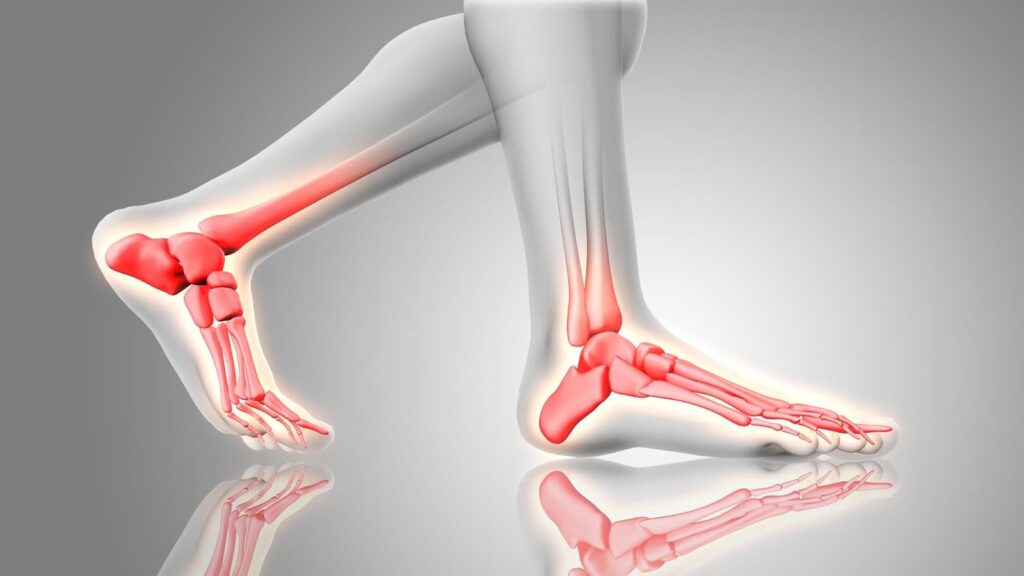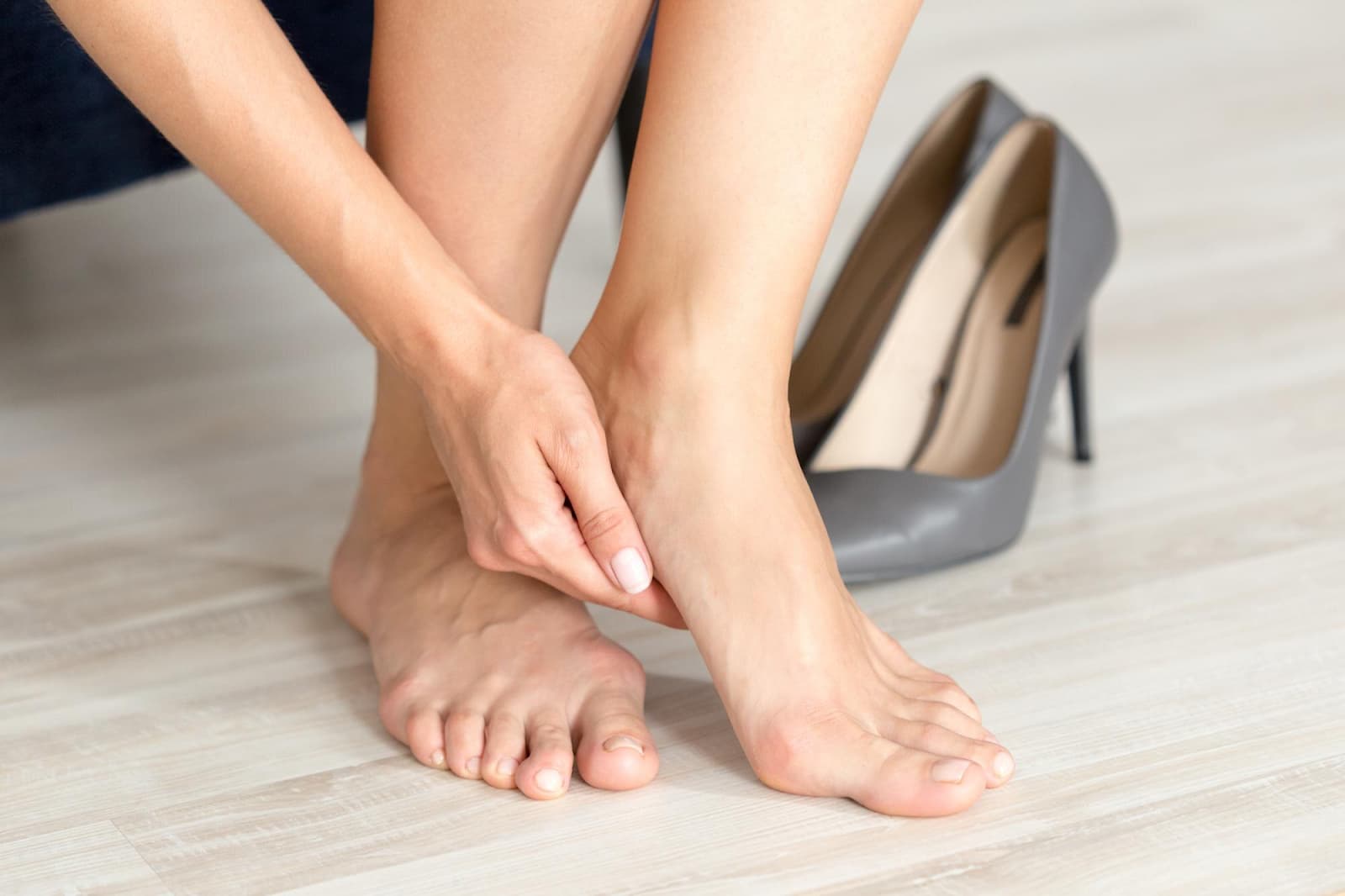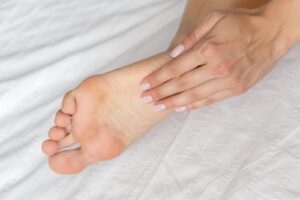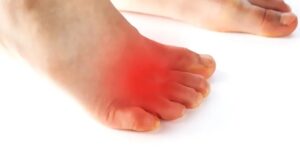Heel pain is a common complaint that can significantly impact daily activities and mobility. The heel, composed of fatty tissue that cushions and protects the heel bone (calcaneus) along with other foot structures, plays a crucial role in supporting the arch of the foot and distributing forces evenly during movement. Overuse or excessive strain on the heel, especially during physical activities like walking, running, or jumping, can lead to various conditions causing discomfort and pain.
Key Questions Addressed in this Article:
- What are the common causes of heel pain?;
- How does plantar fasciitis contribute to heel pain, and what are its symptoms and treatment options?;
- What is a stress fracture in the context of heel pain, and how is it diagnosed and treated?;
- What are cracked heels, and what remedies can be used to address this condition?;
- How are plantar warts related to heel pain, and what are the treatment options available?;
- What is Sever’s disease, and how is it managed, especially in children and adolescents?;
- How do corns and calluses develop on the heels, and what relief measures can be taken?;
- How do heel spurs contribute to heel pain, and what methods can alleviate discomfort associated with them?;
- What is athlete’s foot, how does it affect the heels, and what steps can be taken for management and prevention?;
- What is Achilles tendinopathy, and how can it be addressed through treatment and preventive measures?

Common Causes
Plantar Fasciitis
Plantar fasciitis arises when the plantar fascia, a thick band of tissue on the bottom of the foot, experiences heightened stress, leading to inflammation and pain. This condition is often characterized by sharp pain in the heel or along the arch of the foot, particularly noticeable during the first steps in the morning or after prolonged periods of rest.
Symptoms of Plantar Fasciitis:
- Pain: Typically felt on the underside of the heel or along the arch of the foot;
- Stiffness: Difficulty in moving the foot or ankle, especially after long periods of inactivity;
- Swelling: Inflammation around the affected area, contributing to discomfort.
Plantar fasciitis is commonly managed through a combination of stretching exercises, orthotic devices, supportive footwear, and in severe cases, corticosteroid injections or physical therapy.
Stress Fracture
Stress fractures are tiny cracks that develop in bones over time due to repetitive stress or overuse, hindering the body’s natural healing process. In the context of heel pain, stress fractures often occur in the calcaneus (heel bone) and can result from activities like running, jumping, or sudden increases in physical intensity.
Signs of a Stress Fracture:
- Localized Pain: Intensifies during weight-bearing activities and diminishes with rest;
- Swelling: Around the affected area due to inflammation;
- Tenderness: Increased sensitivity to touch or pressure on the heel bone.
Treatment for stress fractures typically involves rest, immobilization through bracing or casting, modifying activity levels, and sometimes surgical intervention in severe cases.
Cracked Heels
Cracked heels, also known as heel fissures, are a common condition characterized by dry, flaky skin and deep vertical cracks on the outer edge of the heel. Factors such as inadequate foot hygiene, prolonged standing, wearing open-back shoes, or specific medical conditions can contribute to the development of cracked heels.
Remedies for Cracked Heels:
- Moisturizing: Regularly applying emollients or foot creams to keep the skin hydrated;
- Exfoliation: Removing dead skin cells through gentle scrubbing or pumice stone usage;
- Foot Soaks: Using warm water and Epsom salts to soften the skin before exfoliation.
In severe cases, cracked heels may require professional intervention, including debridement of thickened skin or treatment for underlying conditions like fungal infections.
Plantar Warts
Plantar warts are noncancerous growths caused by the human papillomavirus (HPV) that commonly develop on the soles of the feet, including the heels. These warts can be painful, especially when pressure is applied, making walking uncomfortable.
Treating Plantar Warts:
- Salicylic Acid: Over-the-counter treatments to gradually remove the wart;
- Cryotherapy: Freezing the wart with liquid nitrogen to destroy the affected tissue;
- Surgical Removal: In cases where other methods are ineffective, minor surgery may be necessary.
Preventive measures include maintaining good foot hygiene, avoiding direct contact with infected surfaces, and refraining from picking or scratching at warts to prevent spreading.
Sever’s Disease
Sever’s disease, also known as calcaneal apophysitis, is a common cause of heel pain in children and adolescents, particularly those engaged in sports or physical activities. This condition occurs when the growth plate in the heel becomes inflamed due to repetitive stress or tension.
Managing Sever’s Disease:
- Rest: Limiting high-impact activities to alleviate strain on the affected area;
- Ice Therapy: Applying ice packs to reduce inflammation and relieve pain;
- Stretching Exercises: Improving flexibility and strengthening surrounding muscles to support the heel.
While Sever’s disease typically resolves with time and proper management, seeking guidance from a healthcare provider is essential to ensure appropriate care.
Corns & Calluses
Corns and calluses are thickened layers of skin that develop in response to friction or pressure, often forming on the heels or other weight-bearing areas of the feet. These hardened areas can cause discomfort and pain, especially when walking or wearing tight-fitting shoes.
Tips for Corns & Calluses Relief:
- Padding: Using protective pads or cushions to reduce pressure on affected areas;
- Proper Footwear: Wearing well-fitted shoes with ample cushioning and support;
- Regular Exfoliation: Removing dead skin gently to prevent further thickening.
In persistent cases, podiatric intervention may be necessary to address underlying issues contributing to corns and calluses.
Blisters
Blisters are fluid-filled sacs that form on the skin in response to friction, heat, or irritation. While blisters commonly occur on the toes or heels due to rubbing against footwear, they can lead to discomfort and pain if not properly managed.
Treating Blisters:
- Protective Coverings: Using moleskin or blister pads to shield the affected area;
- Sterile Drainage: Carefully puncturing the blister to release fluid and prevent infection;
- Avoid Popping: Refraining from popping blisters to minimize the risk of complications.
Maintaining good foot hygiene, wearing moisture-wicking socks, and ensuring proper shoe fit can help prevent blister formation during physical activities.
Heel Spurs
Heel spurs are bony protrusions that develop on the underside of the heel bone, often associated with conditions like plantar fasciitis or Achilles tendinitis. These spurs can cause sharp pain or discomfort, particularly when walking or standing for extended periods.
Alleviating Heel Spurs:
- Orthotic Inserts: Providing additional support and cushioning to reduce pressure on the heel;
- Physical Therapy: Strengthening exercises to improve foot mechanics and alleviate symptoms;
- Footwear Modifications: Opting for shoes with adequate arch support and shock absorption.
In severe cases, corticosteroid injections or surgical removal of the spur may be considered to address persistent pain and discomfort.
Athlete’s Foot
Athlete’s foot, a fungal infection that commonly affects the skin between the toes and on the soles of the feet, can also manifest on the heels, leading to itching, redness, and peeling skin. This condition thrives in warm, moist environments, making it prevalent among athletes and individuals who wear tight or damp footwear.
Managing Athlete’s Foot:
- Antifungal Creams: Topical treatments to combat fungal growth and alleviate symptoms;
- Foot Hygiene: Keeping the feet clean and dry, especially between the toes, to prevent recurrence;
- Avoiding Contamination: Minimizing direct contact with infected surfaces or sharing personal items.
Prompt treatment and preventive measures, such as wearing breathable footwear and changing socks regularly, can help control and prevent the spread of athlete’s foot.
Achilles Tendinopathy
Achilles tendinopathy refers to conditions affecting the Achilles tendon, the thick band of tissue connecting the calf muscles to the heel bone. Overuse, improper footwear, or sudden increases in physical activity can contribute to the development of this condition, resulting in pain and stiffness in the back of the heel.
Addressing Achilles Tendinopathy:
- RICE Protocol: Rest, ice, compression, and elevation to manage acute symptoms;
- Stretching Regimen: Gentle stretches to improve flexibility and reduce tension in the Achilles tendon;
- Gradual Return to Activity: Gradually reintroducing physical exercise to prevent exacerbation of symptoms.
For chronic cases, physical therapy, orthotic devices, or in severe instances, surgical intervention may be recommended to address persistent Achilles tendon issues.
Conclusion
Heel pain encompasses a spectrum of conditions that can significantly impact an individual’s quality of life and mobility, including signs of healing foot drop. By understanding the common causes of heel pain and recognizing associated symptoms, individuals can effectively manage discomfort. Seeking timely guidance from healthcare professionals is crucial for accurate diagnosis and tailored treatment plans. Remember, proactive foot care and early intervention play key roles in promoting overall foot health and well-being.


